
Most transportation research defines gender as binary—participants are either “male” or “female,” excluding gender diversity. This black-and-white interpretation of gender means some travelers’ needs are overlooked or misunderstood, because gender has a significant influence on people’s behaviors and experiences.
As part of its ongoing effort to make transportation more equitable through its Advancing Transportation Equity Initiative, the Minnesota Department of Transportation (MnDOT) sponsored University of Minnesota research to better understand how gender identity and gender roles influence travel behavior and experiences in Minnesota.
“Our goal was to understand how gender and other social identities such as race, family type, and employment impact travel behaviors and well-being outcomes—information that could help MnDOT effectively plan and maintain the state’s multimodal transportation system for the benefit of all,” says Ying Song, an assistant professor with the Department of Geography, Environment and Society and the project’s principal investigator. Professor Yingling Fan of the Humphrey School of Public Affairs was the co-investigator.
The project began with a literature review that examined how gender has been defined in transportation studies and explored the intersection of gender with race, family role, and other categories that create unique needs and experiences.
Next, the team collected and analyzed data from two different surveys: the Metropolitan Council’s 2019 Travel Behavior Inventory (TBI) and a 2021 survey using the Daynamica™ smartphone app. The app recorded 278 participants’ diaries for 14 days, collecting data about emotions experienced during trips, time allotted to household tasks, and other factors. Researchers used the TBI and Daynamica data to extract distinct activity-travel patterns in Minnesota and associate these patterns with participants’ gender and other social identities.
While the Daynamica survey data contained richer information about gender identity and gender roles than the TBI data, the TBI data had a much larger sample size than the household survey. “Combining and analyzing these two data sources together allowed us to demonstrate how gender and other social identities—including race, employment status, and family role—impact time allocations and travel choices and whether such impacts changed after the outbreak of the COVID-19 pandemic,” Song says.

The study revealed that transportation needs, travel experiences, and subjective well-being vary by gender identity. For example, females do more household tasks and rely more on household vehicles than males and non-binary people, even in dual-income households. Females and non-binary people were more likely than males to feel unsafe while using public transit and were challenged to make multiple stops or travel with strollers or carts using transit. Non-binary people also had fewer positive and more negative experiences than females or males, resulting in the lowest subjective well-being outcomes.
The intersection of gender with other demographic characteristics—such as race, family types, and employment status—created distinctly different behavior patterns, Song says. For example, while females relied more on household vehicles, Black females were more likely to use public transit than females in other racial groups even after the outbreak of COVID-19. Another example was that females with children were less likely to have out-of-home activities and trips than males on weekday afternoons, but Hispanic and Black females were much more likely to have late-afternoon activities than females of other races.
Changes in travel behavior resulting from COVID-19 also varied by gender. For people who stayed home most of the time, females completed more household tasks than males, even when they were employed and working from home during the pandemic. Females also made more trips than males and non-binary people while reducing their use of public transit and relying more on household vehicles. “As a result, females faced more challenges during the pandemic than males due to the typical roles of females in the family, such as caring for children at home and shopping for groceries,” Song says. “This makes them likely to feel more tired than males.”
“This study clearly shows that gender roles influence transportation needs and experiences,” says Hally Turner, director of policy planning with MnDOT’s Office of Transportation System Management and the project’s technical liaison. “People of different genders are having wildly different travel experiences, and many are having negative emotions and experiences. We need to focus our work in planning and policy to avoid these disparities.”
By identifying several key action items, researchers provided ways for MnDOT to put the findings into practice. Suggested actions include:
- Adopting gender-inclusive language in project design and communication.
- Engaging with the community to better understand travelers’ needs, experiences, and the intersectional nature of gender.
- Providing a safer environment for transit users as well as services in the middle of the day for non-commuting travel.
- Partnering with community organizations to collect feedback and avoid marginalizing disproportionately impacted populations.
—Megan Tsai, contributing writer


